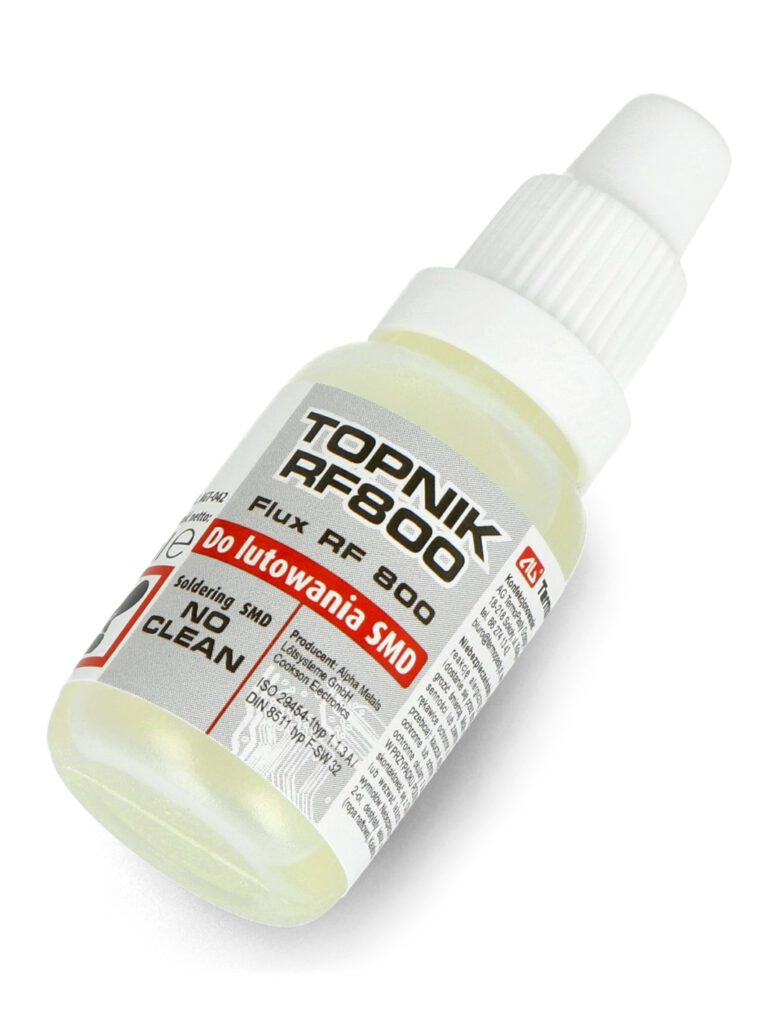Table of Contents:
Every soldering process is slightly different, so don’t hesitate to experiment with different types of fluxes and application methods to find the one that best suits your needs and preferences.
In every attempt, however, you need proven solutions.
Soldering. Which flux for SMD?
Fluxes are an integral part of the soldering process, playing a key role in ensuring a durable and reliable connection between electronic components and the circuit board.
In today’s article, a small overview of fluxes for surface mount device (SMD) soldering.
SMD soldering and fluxes - for a good start
Flux contains active ingredients, such as rosin or organic acids, which react with oxides on the metal surface.
It is worth knowing that there are many types of fluxes available on the market.
These include fluxes based on water, resin, resin alcohol solution (RA) and no-clean.
The right flux for your needs and preferences is a must when seriously considering your work environment, soldering process requirements and post-soldering cleaning preferences. The flux should facilitate the melting of solder, prevent oxidation (oxidation ) and enable the formation of permanent connections.
How it works.
When heated, the flux activates and begins to remove oxides, preventing them from interfering with the soldering process.
A good SMD flux also promotes wetting, which is the ability of molten solder to spread and adhere to metal surfaces.
By reducing the surface tension of the solder, the flux ensures that it flows smoothly and evenly, creating strong and reliable solder joints.
Natural rosin from resin
Perhaps the most basic soldering flux used for more than a thousand years is natural rosin extracted from pine tar resin.
It is distilled to produce the clear, water-white rosin used in soldering fluxes.
Rosin is a collection of naturally occurring acids, mainly abietic acid and its homologs.
When used as a soldering flux, transparent rosin is dissolved in a solvent – usually isopropyl alcohol.
Used in this way, without the addition of acid activators, it is referred to as rosin flux type R. Advantages include environmental friendliness, lack of toxic substances, ease of use and resistance to high temperatures.
However, it requires careful storage – beware of moisture and UV.
Flux no-clean
No-clean fluxes can be made from natural rosin or contain synthetic resins.
Rosin-based no-clean flux solutions are essentially the same as rosin-based (R-type) fluxes, but usually contain natural rosin gum at a much lower concentration than used in R-type flux solutions (R, RMA and RA).
True synthetic no-clean fluxes contain resins… well, synthetic resins, which give the flux the same desirable properties as a natural rosin product.
Solutions of no-clean fluxes may also contain additional activators, and it is worth remembering that their residues can lead to corrosion.
The unquestionable advantage is that no-cleaning is not necessary, resulting in time and cost savings.
Water-soluble fluxes
Water-soluble fluxes use water-soluble resins, the residue of which must be removed with a water rinse.
Some water-soluble fluxes are water-based solutions, eliminating the need for an alcohol-based flux solution.
This is one way to reduce VOC emissions for those manufacturers that operate under strict environmental regulations.
Acid activators commonly used in water-soluble fluxes include organic acids, compounds containing chlorine or bromine, amides and organic salts.
Activators are corrosive and should be removed from the circuit board to ensure long-term reliability.
They are safe, odorless and easy to clean, but are less effective in soldering plastics, aluminum or simply materials with high thermal conductivity.
Fluxes for SMD at Botland
An interesting suggestion is AG5 flux for soldering SMD boards.
The application method is a brush paired with a 100ml bottle.
It will work great for tinning processes (working temp range of about 300ºC – 400ºC) and soldering components that are coated with polyurethane varnishes.
Another option is Flux TK83 – An alcoholic rosin solution with organic activators.
It is used for working with temperatures max.
up to 280°C.
It will prove useful wherever mixed assembly, wire end whitening and machine soldering in professional and consumer electronics are required.
At the same time, one of the basic parameters to which it is mandatory to pay attention comes to the fore here – the planned nature of work is, of course, related to the operating temperature that we will set on our soldering station.
The best fluxes and colophons at Botland is a collection of must-have materials and accessories for every workshop – in their descriptions on the store’s website you will find not only precise technical parameters, but also hints on the suggested application.
How useful was this post?
Click on a star to rate it!
Average rating 0 / 5. Vote count: 0
No votes so far! Be the first to rate this post.




















